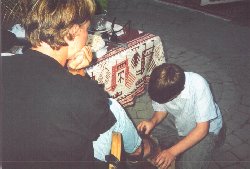
Turkey . . .
20 May 98
It’s a relaxing 90-minute boat ride across the Straights of Lesvos from Mytilini, Greece to Ayvalik, Turkey. Immediately upon arrival the fiscal gouging begins. At customs and passport control we are informed that Turkey has just raised its tourist tax (for U.S. passport holders only!) from $20 to $45 per person. Next we went to find a car rental, and again walked out feeling like we got screwed . . . the best deal we could find was $300 for a beat-up old Fiat sedan for four days. Unfortunately for us, the scamming and hustling is a way of life in Turkey, and it never lets up. We’re perpetually in a defensive mode, and we don’t like it.
Dealing with the currency is going to be a challenge: the exchange rate is around 300,000 lira to the dollar. We carry around great wads of bills (most of which are not of a size to fit handily into a wallet) and need be careful about the number of zeros on them when making purchases.
We drove south from Ayvalik along the coast to Bergama to visit the extensive ruins of Pergamum.
It was in the great library of ancient Pergamum that the first books (with pages) were invented in 175 BC. Across the valley we could see the hilltop ruins of the Asclepion of Pergamum, the medical school and center founded by Galen. He was the personal physician to Marcus Aurelius and considered to be the founder of Western medicine.
South from Bergama through Izmir to the bustling, hustling town of Selcuk, where we took a room at the Otel Kalehan. We walked around the town in the evening. While waiting for dinner at a streetside cafe, Kaaren ultimately came to terms with an especially comely little urchin who insisted upon shining her sandals.

21 May 1998
After breakfast we hiked up the hill behind our hotel to view the Basilica of St. John
(where he came with the Virgin Mary and wrote his Gospel shortly before he died). Next, a
short distance west of town, we visited the ruins at Ephesus: the trading, religious and
cultural center of ancient Ionia. These are the grandest and best-preserved classical
ruins in the eastern Mediterranean. Many significant events in the history of Christianity
took place around Ephesus. St. Paul wrote his ‘Letter to the Ephesians’ to
citizens he had known during his three-year stay here.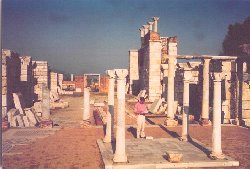
At the Ephesus Museum we viewed the statuary, mosaics, and artifacts collected from historical sites in the area. Most memorable were the marbles of the many-breasted fertility goddess Artemis, the bronze figure of the Boy on a Dolphin, and the intimidating effigies of Priapus, the phallic god.
From Selcuk we drove a long westward loop into central Anatolia, passing through (and
usually getting lost in) many towns and cities, including Silihli (where coins were first
invented by King Croseus). At Balikesir we turned back to the west and late in the evening
ended up at the quaint little harbor town of Assos and found a room at the Hotel Assos for
the night.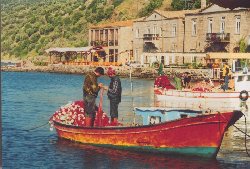
Early the next morning we were up for breakfast at the water’s edge, watching fisherman tending their nets after they’d been out on the water all night.
May 22 1998
Assos north to Cakkanale, to catch a ferry across the Dardenelles (at which point we
officially crossed from Asia back into Europe). We spent the afternoon exploring the
national park which now surrounds the battlefields of Gallipoli. Stood atop the little
hill above Anzac Cove, where the Australian and New Zealand forces made their landing. 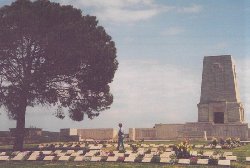 In what must have been one of the
most pointless and savage battles in the annals of warfare, 28,000 men died on the 5th
of August 1915, in an effort to take this scrubby, 100 meter-long ridge. It was all for
naught as the Turks, led by Gamal Ataturk, held their ground and the Commonwealth Forces
were forced to withdraw. The final toll at Gallipoli was over 100,000 lives lost from both
sides.
In what must have been one of the
most pointless and savage battles in the annals of warfare, 28,000 men died on the 5th
of August 1915, in an effort to take this scrubby, 100 meter-long ridge. It was all for
naught as the Turks, led by Gamal Ataturk, held their ground and the Commonwealth Forces
were forced to withdraw. The final toll at Gallipoli was over 100,000 lives lost from both
sides.
We then drove 40 kms east along the Sea of Marmara and took another ferry back across
to Asian Turkey. Then on to Bursa where we found a hotel for the night.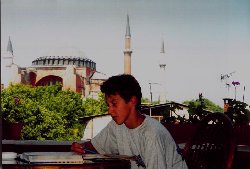
May 23 1998
East along the southern shore of the Sea of Marmara, then a ferry across the Bosporus
to Istanbul. Raining hard and absolutely insane traffic over pot-holed roads. Quickly as
possible we found an Avis agency and dropped the car off. The agent there was appalled
that Avis was associated with the beat-up car we’d been driving. Caught a cab to the
old part of town at Sultanhamet and found our room at Hotel Spina. The Spina is perfectly
located for exploring old Istanbul. A few minutes’ walk takes you to the Blue Mosque,
the Aya Sofia, or Topkapi Palace.
May 24 1998
This morning we discovered a certain disadvantage to being situated so near to the mosques: the morning call to prayer. The muezzin are beautiful to listen to, but so amplified as to rattle the windows . . . hard to appreciate at 4:30 a.m.
After breakfast we walked to Topkapi Palace . . . residence of the Sultans, their huge families, and the Jannisaries. Among the tens of thousands of other splendid artifacts, we saw the swords and bows of Mohammed, the Topkapi Dagger (that which Peter Ustinov attempts to steal in the movie "Topkapi"), and the magnificient Spoonmaker's Diamond. The Harem was almost a small city unto itself within the huge palace, and we learned that life there was a much more complex social phenomenon than we'd ever imagined.
May 25 1998
Hopped onto a packed and very aromatic tram that took us to the middle of Istanbul for a visit to the Grand Bazaar. One can probably buy anything there, if you find the right person to ask . . . mostly the touts ask you. Dan found a Meerschaum pipe for Ted. Lots of fake Meerschaum around, so we had to shop carefully.
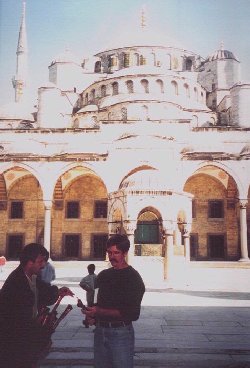
For lunch we went back to our hotel to sit on the rooftop terrace and sample delicacies we’d purchased at the bazaar: bread, olives, salami, pickled veggies, cheese, stuffed grape leaves, bread, wine.
After lunch we went next door to tour the incredible Blue Mosque. We had to wait until afternoon prayers were over before we could enter (exchanging shoes for slippers). Built by Sultan Ahmet I in the early 16th century, it is a beautiful and elegant edifice covering several acres. The ‘blue’ in the mosque’s name comes from the glazed tiles that line the walls.
Outside in the courtyard, Dan, ever the sucker for a new music-maker, haggled with a vendor over the price of a strange, double-reeded instrument.
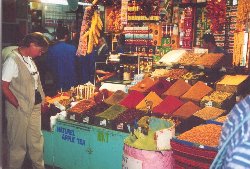
May 26 1998
In the morning we walked to the Egyptian Bazaar. The spice stalls fill the air with intoxicating aromas, and are visually beautiful as well.
After lunch we visited the huge mosque of Aya Sofia. Built around 600 AD, it was for many centuries the largest unsupported dome in the world. The dome is threatening to collapse, so is now supported by an extraordinary, unfortunately quite obtrusive, network of scaffolding. Kaaren was charmed by this old fellow we found sitting outside on the steps of the mosque, crocheting caps. She bought two of them from him.
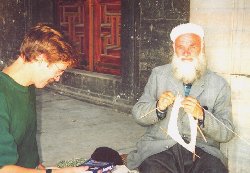
May 27 1998
One more trip to the Grand Bazaar to look for gifts for Darwin and Dorothy. In the early afternoon we caught a cab to the airport for our 1530 flight from Istanbul to Vienna.
The next page is: Austria . . .